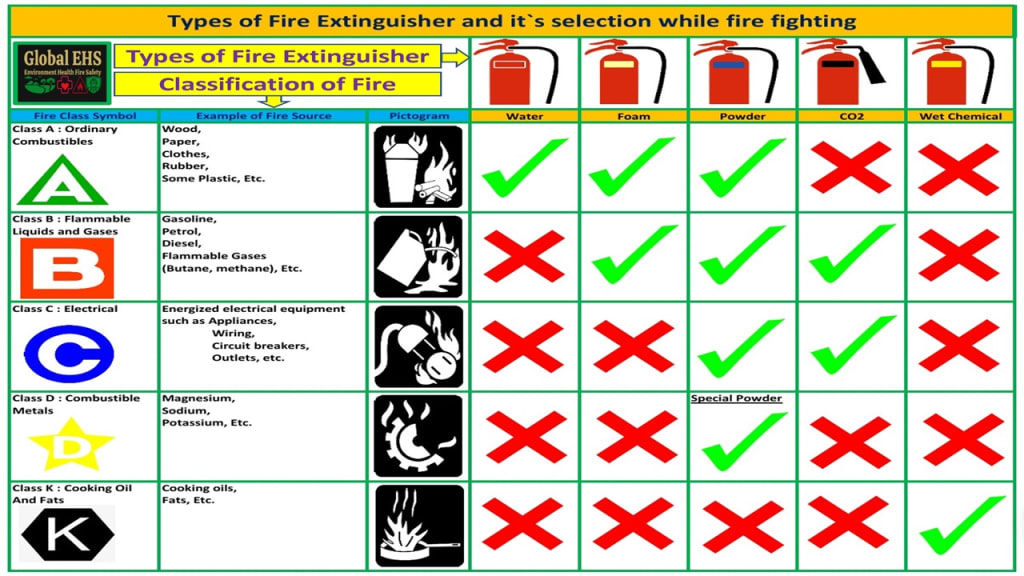
It is necessary to understand the components, types, operation and maintenance of fire extinguishers, so that individuals can be better prepared to handle fire emergencies effectively.
Definition of Fire Extinguisher:
A fire extinguisher is a portable device designed to extinguish or contain small fires in an emergency. This is usually a pressurized vessel with a deployable fire extinguishing media to prevent flames. Fire extinguishers are an integral part of fire protection equipment and are commonly found in residential, commercial, industrial and public buildings.
Key Components:
1. Container: The body of the fire extinguisher, usually made of metal, that holds the extinguishing agent under pressure.
2. Extinguishing Agent: The substance used to put out the fire. Common agents include water, foam, dry chemical powder, carbon dioxide (CO₂), and wet chemicals.
3. Pressure Mechanism: A system that pressurizes the extinguishing agent to enable its discharge. This typically involves a compressed gas (such as nitrogen) or a manually operated pump.
4. Hose and Nozzle: A flexible tube (hose) and a directing nozzle that allow the user to aim and control the discharge of the extinguishing agent.
5. Handle and Trigger: The handle is used to carry the extinguisher, and the trigger or lever is used to activate the discharge mechanism.
6. Pressure Gauge: Indicates whether the extinguisher is properly pressurized and ready for use.
7. Safety Pin and Seal: Prevents accidental discharge. The pin must be removed to activate the extinguisher, and a tamper-evident seal ensures it hasn't been used or tampered with.
Operation of Fire Extinguisher:
The typical operation of a fire extinguisher can be remembered with the acronym PASS:
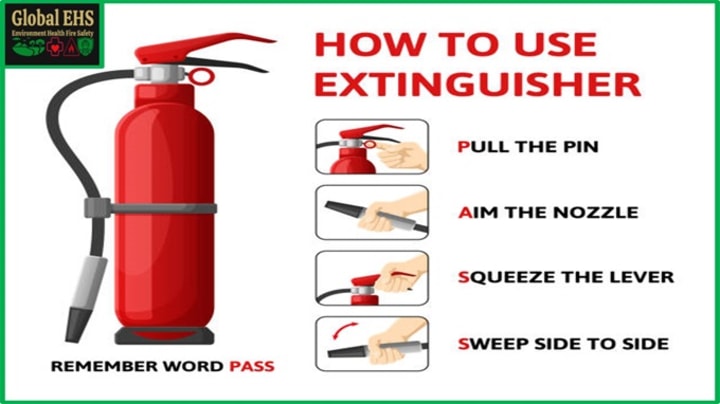
Pull the safety pin.
Aim the nozzle or hose at the base of the fire.
Squeeze the handle or trigger to release the extinguishing agent.
Sweep the nozzle from side to side at the base of the fire until it is extinguished.
Maintenance of Fire Extinguisher:
• Regular fire extinguisher inspections are necessary to ensure that they are working properly.
• The pressure gauge should be checked to ensure that the fire extinguisher is fully charged.
• Professional maintenance and service should be performed annually or as recommended by the manufacturer.
Different types of Fire Extinguishers (Based on extinguishing media):
There are some common types as given below;
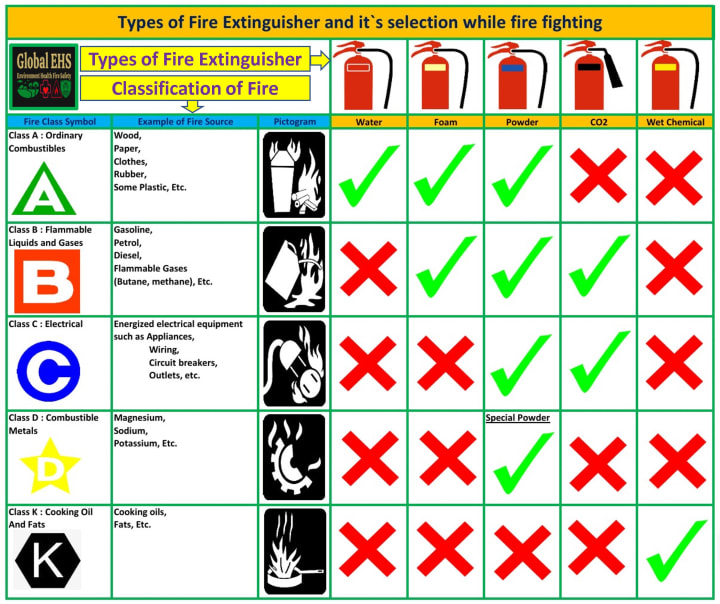
1. Water (Class A):
• Identification: Red Neckband
• Use: Effective on fires involving ordinary combustibles such as wood, paper, cloth, and some plastics.
• Not Suitable For: Fires involving flammable liquids, electrical equipment, or metals.
• Label: Green triangle with an "A".
2. Foam (Class A and B):
• Identification: Cream (Lemon Yellow) Neckband
• Use: Suitable for fires involving flammable liquids (Class B) as well as ordinary combustibles (Class A).
• Not Suitable For: Electrical fires (unless specified as safe) or metal fires.
• Label: Green triangle with an "A" and Red Square with a “B”.
3. Dry Powder (Class A, B, C, and D):
• Identification: Blue Neckband
• Use: Versatile; can be used on fires involving ordinary combustibles, flammable liquids, flammable gases, and combustible metals.
o Class D: Special powders are designed for metal fires.
• Label: Green triangle with an "A" and Red Square with a “B” and Yellow Star with a "D".
4. Carbon Dioxide (Class B and C):
• Identification: Black Neckband
• Use: Effective on fires involving flammable liquids (Class B) and electrical fires (Class C).
• Not Suitable For: Ordinary combustibles and metal fires.
• Label: Red Square with a “B” and Blue Circle with a "C".
5. Wet Chemical (Class K):
• Identification: Yellow Neckband
• Use: Specifically designed for fires involving cooking oils and fats (Class K).
• Not Suitable For: Most other types of fires.
• Label: Black hexagon with an "K".
6. Clean Agent (Class B and C):
• Identification: Green Neckband
• Use: Effective on flammable liquid fires (Class B) and electrical fires (Class C). Clean agents do not leave residue, making them suitable for protecting sensitive equipment.
• Label: Red Square with a “B” and Blue Circle with a "C".
Applications of Fire Extinguisher:
Fire extinguishers are needed to:
• Homes: To quickly deal with kitchen fires, electrical fires, or minor incidents before they spread.
• Workplace: Safety regulations require employees to ensure that they can respond to fire.
• Public housing: For the safety of residents in an emergency.
• Vehicles: Especially in commercial and industrial areas where flammable materials may be present.
Available weights of fire extinguishers in the market:
• Different weights available in market depending on the manufacturer, Like : 1, 2, 3, 6, 9, 12, 18 kg, etc.
• Commonly 6 kg weight Fire Extinguisher are used in major premises for the benefit of easy carriage and movement.
• For specific locations like gas stations, near solvent yard, near panel room weight up to 45 kg are used for manual extinguisher and moved using wheels or trolleys.
Fire Extinguisher Placement:
The distribution of manual fire extinguishers within a building is governed by various safety codes and standards to ensure effective and accessible fire protection. Here are the key considerations and guidelines for distributing fire extinguishers within a building:
Key Considerations for Fire Extinguisher Placement:
• Types of Hazards: Identify the types of fire hazards present in different areas of the building. This determines the type and rating of fire extinguishers needed (e.g., Class A for ordinary combustibles, Class B for flammable liquids, Class C for electrical equipment).
• Accessibility: Fire extinguishers must be easily accessible in case of an emergency. They should be installed in visible locations, along normal paths of travel, and near exits.
• Travel Distance: The maximum travel distance to reach a fire extinguisher is specified by fire codes. Refer applicable rules and regulation (For e.g. NFPA 10) and implement it.
• Mounting and Visibility: Fire extinguishers should be mounted on brackets, in cabinets, or on wall hooks, typically 3.5 to 5 feet above the floor for easy access. Signage should be used to indicate the location of fire extinguishers, especially if they are not immediately visible.
• Special Hazard Areas: Areas with specific fire hazards (e.g., kitchens, laboratories, mechanical rooms) may require additional or specialized fire extinguishers (e.g., Class K for kitchens).
About the Creator
Global EHS
Personnel with a industrial experience in Environment, Health, Fire and Safety. I share insights on Environment, health, Fire and safety to promote a safer, healthier and environment friendly world. Join me in making a positive impact!
Enjoyed the story? Support the Creator.
Subscribe for free to receive all their stories in your feed. You could also pledge your support or give them a one-off tip, letting them know you appreciate their work.

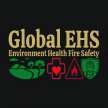
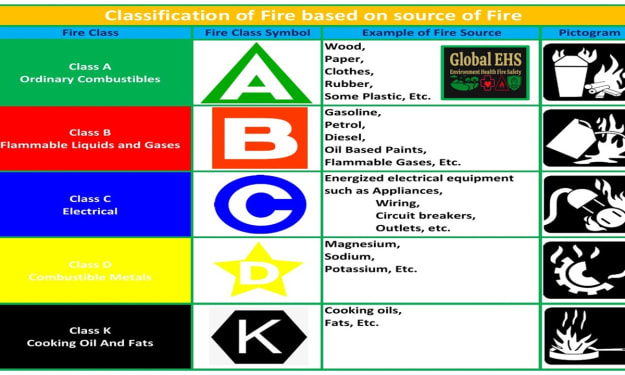



Comments
There are no comments for this story
Be the first to respond and start the conversation.